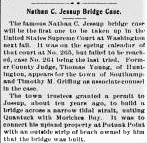We promise we shall have something brand new this week. No telling you about our two museums which are open both Friday and Saturday from 10 – 1. No siree bob.
This week, we plan on introducing you to a gentleman that we know almost nothing about. Sounds boring and daunting, but this individual seems to have been a voice in our community that more than a few appreciated. Who was this vague man? His name was Nathan Jessup.
Are we confused yet?
t being entertained by the news in the Seaside Times, we came across a blurb about Nathan C. Jessup. Seems that a few fine citizens believed that a monument should be built at Sugar LoafLet’s start at the beginning. While spending a quiet momen – that tall hill in Shinnecock Hills on the way to Southampton – to honor Mr. Jessup. Gee, this sounds juicy. Who was Nathan Jessup and why would the community build him a monument? And why at Sugar Loaf of all places.
So, we nimbled up our fingers and tried to piece together the facts, the suggestions, and probably more than a bit of conjecture. It’s a bit like trimming the jigsaw puzzle pieces that don’t quite fit.
An 1893 East Hampton Star article corrected a Brooklyn Eagle article which stated that only two Old 49ers were still alive. No, not football players – miners, gold diggers, Sutters Mill and all that. Seems that they should have said “alive in New York City,” because the Star listed a full 24 names of Old 49ers still alive and kicking right here in East Hampton and Southampton Towns. Yes, one of them was Nathan C. Jessup of Quogue. But was he ‘our’ Nathan Jessup? If he lived in Quogue, why build him something in Shinnecock Hills? Hmmm…
There is a Nathan Jessup buried in Oakland Cemetery in Sag Harbor, but he died in 1854. A bit more sleuthing and we found another Nathan buried in the Westhampton Presbyterian Church Cemetery. Nathan Cooper Jessup was born in November of 1833 and passed away in February of 1910. Sounds feasible.
So what did he do? 1888 saw him purchase the old Presbyterian Church for the sum of $500 to turn into a residence. We can assume that Nathan was involved in community politics, as in 1897 he circulated a petition from Speonk to Quogue to change the route of the railroad so it would pass right through the center of these towns – which it doesn’t, really, so we guess the petition failed. In April of 1900 he was mentioned in a Town Meeting at the Agawam Hall. Doesn’t specify much of what happened there, other than the Good Grounders in attendance did not approve repairs to Flanders Road. That fits. 1901 brought a petition to reclaim rights to the Peconic River and Bay.
In the summer of 1900 things started getting interesting with Nathan. Seems that, in 1887, he was granted the right by Southampton Town to make a roadway and bridge from Quantuck to Moriches Bay. Other articles claim it was the Great South Bay at Potunk Point. Yet another article said the east end of the South Bay from Potunk Point to New Beach, then Potunk Neck at Westhampton to the beach. The changing of names and the use of familiar names often confuses the bibliomaniac.
At any rate, his structure was not to impede the “ebb and flow” of the creek. Old Nathan built a solid embankment with a 20 foot opening. He put it on pilings and covered it with planks. There must have been mutterings from the start, because in 1897 he was slapped with a $10 fine regarding work on the bridge. Clearly he was undeterred and decided more was better, because a few years later he started constructing a 200-foot solid roadway and digging up the surrounding bay bottom. It seems the construction caused an “inundation of the meadows back of the bay” and so the trouble began.
Perhaps the Town and Nathan had differing opinions on what they’d agreed to, because the next thing you know, Nathan was in court defending what he’d built. Nathan was defended by Charles M. Stafford Esq. of Brooklyn, known to be an enthusiastic upholder of the Dongan Patent. The case was taken all the way to the New York Supreme Court. This generated lots of interest. Jessup’s bridge was deemed to be the most famous bridge East of the East River. Nathan didn’t seem to be a quitter; he filed a suit against Edgar Wicks for $10,000 in damages to his bridge when Wicks cut away the drawer to get his skow through! Didn’t do well in that lawsuit either and ended up winning only $225 in damages. While he initially lost his case, by 1903 he was awarded victory in his case against the Southampton Trustees by the Court of Appeals.

Somewhere in all this bickering, he managed to have raised 800 bushels of potatoes to the acre.
In 1903, Capt. Jessup (not sure when that happened) claimed bicycle licensing was illegal and set about proving it. Not sure if this was a difficult cause, but shortly after the papers were reporting he was ill. It was during this year that rumor had it he was offered $75,000 for his land and bridge! He was said to be holding out for $100,000.
Sadly, in 1905, Nathan was reported as having paralysis of his lower extremities due to his being attacked two years before. Further research showed the attack was of the nerve variety. The article continues that his mind was as clear as during his defense of his bridge, which was then rotting away due to neglect. Win some, lose some.
In 1917 the papers mentioned that Mr. & Mrs. Nathan Jessup attended the 30th wedding party of Mr. & Mrs. Harry Jessup. Probably not the same Nathan – a son?
In spite of the accumulated legal fees, we are fairly certain that our Nathan was far from a poor man. In 1905, he sold approximately 110 acres on Potunk Neck for $17,050.
In the end, Mr. Jessup didn’t get much more than a brief mention of his passing. Never found a mention of wife or a children…just a few siblings. No monument was built to our knowledge, more’s the pity. But the road that runs in Westhampton Beach over the current bridge at Potunk Point to the dunes is Jessup Lane. Named after our guy? Hope so.
1910
But why did some people want a monument to him – if it was him – at Sugar Loaf? Many things, known to all at the time, get lost in history, because it is not written down. But don’t worry about yourself – people looking at you in a hundred years will be able to see your Facebook page. We guess that is a good thing.
